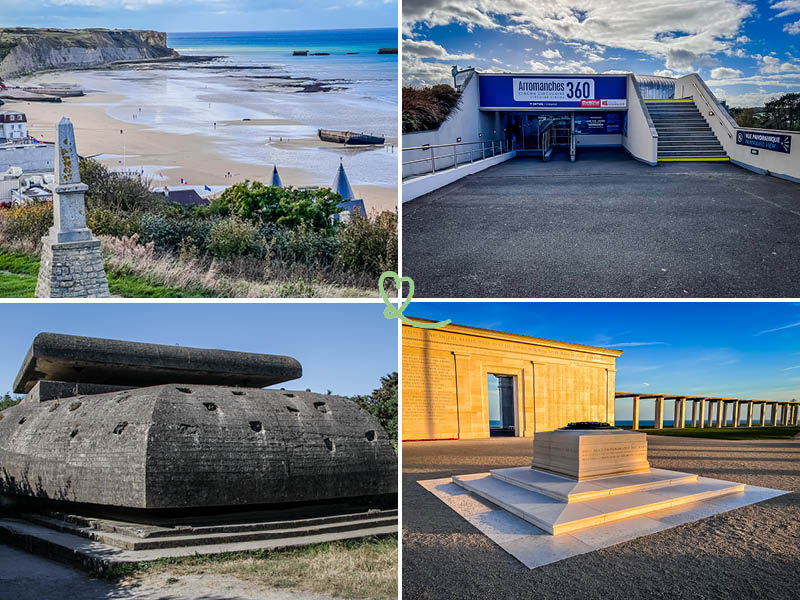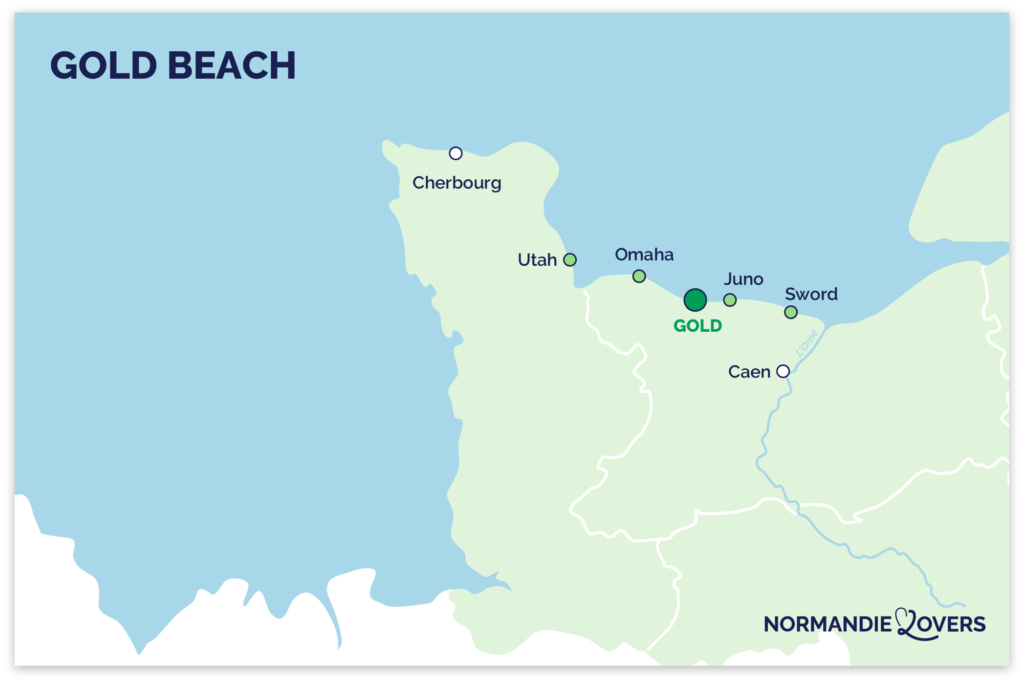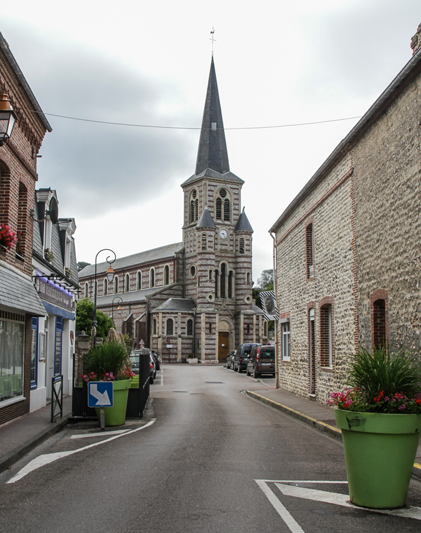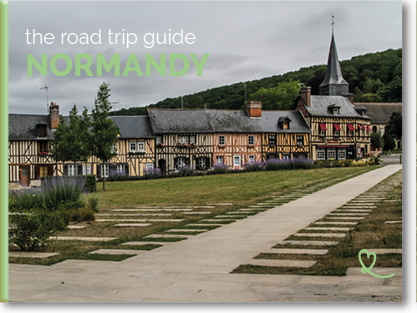Visiting Normandy? The D-Day landing beaches are a must-see, and will give you a better understanding of the Second World War. These include Gold Beach, the beach where British troops landed on June 6 1944.
With its remnants of bunkers and the artificial Mulberry harbour created by the Allies, a visit to Gold Beach is an unforgettable experience. Located between the Calvados towns of Asnelles and Ver-sur-Mer, it is surrounded by other major D-Day sites.
In this article, we give you 9 ideas on what to do at Gold Beach, as well as lots of practical advice in pictures.

This review is completely independent, we visited anonymously and paid our entrance tickets in full.
The Landing at Gold Beach – Introduction
D-Day and the role of Gold Beach
25,000 soldiers of the British 30th Corps landed at Gold Beach on the eve of D-Day. Their objective? Liberate Bayeux, take possession of the axis linking it to Caen, and link up with the Canadians, who landed at Juno Beach, and with the Americans at Port-en-Bessin, after landing at Omaha Beach. Most of these objectives were achieved during the day, although the British encountered strong German opposition in the Asnelles sector. The capture of Arromanches paved the way for the creation of the artificial port of Mulberry, a considerable asset for the Allies in the aftermath of the conflict.

What to see at Gold Beach
At Gold Beach, you’ll see many relics of the Second World War at low tide (bunkers, floating lanes of the artificial port of Arromanches…), as well as numerous museums and memorials on the D-Day landings. We list them below.
You will soon have access to a short video listing the must-do activities at Gold Beach.

Practical tips and map: Gold Beach Normandy, France
Where is Gold Beach?
Gold Beach is a large beach stretching from the commune of Asnelles to that of Ver-sur-Mer.
- Driving time from Rouen: 1h55,
- Driving time from Bayeux: 30min,
- Driving time from Caen: 40min,
- Driving time from Deauville: 1h20,
- Driving time from Cherbourg: 1h30,
- Driving time from Paris: 3h15.
Here is a map to help you find your way:

How to get there
- By public transport: difficult access, take a train to Bayeux then the Nomad 74 bus (stop at Arromanches-les-Bains or Asnelles).
- Guided tour from Bayeux – see program and availability.
- Guided tour from Caen – see program and availability.
- Guided tour from Paris – see program and availability.
- By car: the easiest way to see everything. From Paris, take the A13, then the D7.
OUR ADVICE FOR RENTING A CAR IN Normandy
- Compare prices on our preferred platform: DiscoverCars – one of the best rated sites.
- Choose a car that is comfortable enough (distances can be long) but compact (some parking lots and villages are narrow).
- Think of thecomplete insurance (some roads are tortuous and narrow).
- There is a lot of demand, book it early.

How much time should I allow?
We recommend that you allow at least half a day to visit Gold Beach and the Ver-sur-Mer British Memorial overlooking it.
If you have the time, we recommend you spend at least a day there to also visit Arromanches-les-Bains and see the remains of its artificial harbour. Stay longer if you want to discover the sites on our list, or the other D-Day beaches!

What to do at Gold Beach if you only have half a day or one day?
If your timing is tight, we recommend you prioritize the following activities:
- walk on the beach,
- pay their respects at the British Memorial in Ver-sur-Mer,
- enjoy the view from the Cinéma circulaire in Arromanches-les-Bains,
- visit the 360° circular cinema at Arromanches-les-Bains,
- stroll along the beach of the artificial port of Arromanches.
Plan to visit Arromanches beach at low tide to get a good look at the bunkers. Of course, if you have more time, we recommend exploring the other sites listed in this article to complete your D-Day experience.

See organized day tours of D-Day sites.
1. Visit the beach and its bunkers
Why visit the beach?
The long beach will give you an idea of the scale of the British effort to land in the Gold Beach area. You have to be able to visualize the boats loaded with young fighters arriving in the distance, in the fog of dawn. Then position yourself with your back to the sea to observe the German defense points, a good way to imagine how the Allied soldiers must have felt. Take time to stroll along the beach from Ver-sur-Mer to Arromanches-les-Bains. It is in these two cities that the most remains are concentrated. Go at low tide to get a good look!

What you will see
In Ver-sur-Mer, you’ll find numerous casemates and anti-tank walls. Take the Ver-sur-Mer beach lifeguard station, for example. You’ll notice that it’s built on the foundations of a flanking casemate. All along the beach, you’ll see bunkers and commemorative plaques, all the way to the beach at Arromanches-les-Bains. This is undoubtedly the most impressive part of Gold Beach, visible at low tide. The remains of the floating lanes and Phoenix caissons that form the roadstead of Mulberry’s artificial harbour will give you an idea of the scale of the infrastructure conceived by Winston Churchill. It enabled 400,000 soldiers, 4 million tons of equipment and 500,000 vehicles to land in the space of 100 days.

Practical advice
The beach is accessible free of charge all year round. We advise you to check the weather conditions before you go, as this is an entirely outdoor visit. However, if you want to visit in D-Day conditions, opt for a foggy day and go at dawn.

Gold Beach is less frequented than other D-Day beaches, such asOmaha Beach. Nevertheless, the Arromanches-les-Bains area is very popular with visitors, as it is centrally located among the D-Day beaches and allows them to see the remains of the artificial harbor at low tide. If possible, we recommend avoiding school vacations. The anniversary of D-Day (June 6), as well as other major official events (such as Memorial Day, which takes place on the last Monday in May at Omaha Beach), can draw crowds to the D-Day beaches.
STAYING NEAR THE D-Day beaches
Option 1: Bayeux
The most practical option, in our opinion, is to base ourselves in the town of Bayeux. We recommend..:
- Hotel Domaine de Bayeux in an 18th century mansion – see prices, photos and availability
- see all top rated accommodations in Bayeux

Option 2: in the countryside
In the countryside around the D-Day beaches, you will find beautiful buildings with a lot of charm: farms, manors…
- Hotel Domaine d’Utah Beach – prices, pictures and availability
- Hotel Ferme de la Rançonnière – prices, pictures and availability

Option 3: next to one of the beaches
If you’re looking for a seaside holiday or are fascinated by one of the beaches, you can choose a more specific hotel:
- Hotel Villas d’Arromanches in Gold Beach Beach – prices, pictures and availability
- Hotel La Sapinière in Omaha Beach Beach – prices, pictures and availability

2. Visit the Cinéma 360 d’Arromanches
Why visit Cinéma 360 d’Arromanches?
Arromanches 360 is a small theater using nine circular screens projecting archival images (from the USA, Canada, France and Great Britain). We plunged into the heart of the history of the Battle of Normandy through this emotionally-charged immersive experience. The cinema’s roof terrace offers superb panoramic views of the D-Day beaches, Gold Beach in particular.

What you will see
In addition to a film featuring archive footage, the visit is rounded off by explanatory panels on the historical context and chronology of this tormented period. We also saw objects that belonged to the British troops who liberated Caen in July 1944! On the roof, you’ll have access to an orientation table.

Practical advice
Cinéma 360° is located in the hills above Arromanches-les-Bains. It’s within walking distance of the town center, but also has a large parking area for a fee if you prefer. It is open every day except January, when it closes for the year. This site, designed as an extension of the Caen Memorial, is visited during the school vacations, but also for school outings. Book your visit now!

See our article dedicated to the Arromanches 360° Cinema.
3. Enjoy the view from the Cinéma 360° d’Arromanches
Why enjoy the view from the 360° Cinema?
If you don’t want to visit the Cinéma 360° d’Arromanches, we’d still recommend it. In our opinion, this is the best viewpoint of Gold Beach and the Allied artificial harbour.

What you will see
In addition to a superb panorama of Gold Beach, you’ll have a view of the Normandy countryside where the British 6th Airborne Division landed, and in the distance, a glimpse of Juno Beach, where the Canadians landed. You’ll also see a statue of the Virgin Mary, a war memorial and the impressive floating channel of the artificial harbour. Finally, you can admire a sculpture in tribute to fallen soldiers, which we found particularly beautiful.

Practical advice
This viewpoint is accessible free of charge. There is a charge for parking and the use of binoculars. One parking area is reserved for buses, another for cars, and another for camper vans. There is also bicycle parking. Next door, you’ll find a picnic area. This viewpoint can be reached on foot from the town, but bring good shoes as it’s quite a steep climb!

4. Visit the Landing Museum at Arromanches
Why visit the Musée du Débarquement d’Arromanches?
The Musée du Débarquement in Arromanches offers a very different view of the D-Day landings. It focuses on the creation of artificial harbors that facilitated the unloading of military vehicles (Mulberry Harbors).
Thanks to this British creation, they were able to unload 9,000 tons of material per day! In 2023, it moved to a new building, and we can’t wait to get back!

What you will see
The museum’s collection is made up of models, which we really enjoyed: they give us a better understanding of how artificial harbors work. The museum also boasts a number of authentic objects, most of them items of equipment that once belonged to the soldiers. Its new museography includes immersive features (projections of archive images, etc.). In 2024, its roof terrace will be open to the public!

Practical advice
The Musée du Débarquement d’Arromanches is located on the beachfront. Several pay parking lots are available nearby. It is accessible to people with reduced mobility and includes a checkroom and store. The audioguide is included in the tour price and is available in 10 languages. The audio tour lasts around 1h30. The museum is open all year round, except in January when it closes for the year.

4. Explore the Longues-sur-mer Battery
Why explore this battery?
All along the Normandy coast, you can discover bunkers and important German war batteries. These include the Longues-sur-Mer battery. It was a key element of the Atlantic Wall. Today, it is one of the best-preserved sites with its original cannons.
Despite the air raids of June 5, 1944, the artillery was still operational on the 6th. It was deactivated by the bombs sent by the warships.
The free walking path takes you to the various buildings with sea views.

What you will see
In addition to a fire command post and four casemates, each housing a 150mm artillery piece, you’ll see mortars and an ammunition bunker.

Practical advice
The Longues-sur-Mer Battery is freely accessible all year round. You can park in the public parking lot, a 5-minute walk away. The tourist office is right next to the parking lot. Toilets are also available. Numerous guided tours of the site take place throughout the year: see program and availability.

Read our article on the Longues-sur-Mer Battery.
5. Remembrance at the British Memorial at Ver-sur-Mer
Why go to the Ver-sur-Mer Memorial?
Located on the heights of Mont Fleury in Ver-sur-Mer, the British Memorial overlooks the Gold Beach area. Conceived in 2015 by veteran George Batts, the memorial was inaugurated in 2021. Prior to this date, the UK was the only Allied nation not to have its own national memorial in Normandy, but several cemeteries. This place of remembrance invites us to remember the 22,442 soldiers of the British Army who fell in battle, as well as the members of the merchant navy and civilians killed on Normandy soil between June 06 and August 30, 1944.

What you will see
Entrance to the memorial is via a path lined with stones recalling the events of the Battle of Normandy. Then, in the center, there’s a wall dedicated to the British soldiers who fell on D-Day. Next to it, a sculpture bears the first words of the BBC’s announcement on the morning of June 6, informing the world that the liberation of Europe had begun. On the 160 Burgundy stone columns that make up the site, are inscribed the names of those who died in the following days, in chronological order. To the west, a memorial pays tribute to the French civilians who lost their lives during the Battle of Normandy. We recommend this very moving visit.

Practical advice
The memorial is open all year round. Pay parking is available at the entrance to the site, where you’ll also find toilets, a picnic area and free Wi-fi. In fact, there’s an app to guide you on your visit. It’s an 8-minute walk to the memorial. For more information, visit the official website here.

MORE ABOUT THE D-Day sites
- The best landing sites to visit
- Visit the 5 D-Day landing beaches
- Where to stay – best hotels near the beach
- The best D-Day museums in Normandy
- German batteries to visit
- Car rental tips: Caen – Roissy-CDG – Orly – Beauvais
- Visit Omaha Beach
- Visit Utah Beach
- Visit Gold Beach
- Visit Sword Beach
- Visit Juno Beach (coming soon)

6. Visit the Musée des Épaves Sous-Marines du débarquement at Port-en-Bessin
Why visit the Underwater Wreck Museum?
The Musée des Épaves Sous-Marines in Port-en-Bessin offers a unique approach to the D-Day landings. It retraces 35 years of underwater mining, which brought to light the personal belongings of soldiers found in warships sunk around June 6, 1944.

What you will see
In addition to the soldiers’ personal items, you’ll see tanks, mines, torpedoes, cannons, bulldozers and all manner of mechanical parts. These are the relics we appreciated most during our visit, but photos and a 50-minute documentary featuring numerous testimonials are also on show.
Practical advice
This small private museum is located on the D6 towards Port-en-Bessin, in the commune of Commes. It is open only in season, i.e. from June 1 to September 30, from 10am to 12pm and 2pm to 7pm, except on Saturdays. In May, it is open only on weekends and public holidays.
Subscribe to our Newsletter
- Get away from it all with Region Lovers’ beautiful destinations!
- Once a month
- Advertising-free
7. Go to Ryes Commonwealth Military Cemetery in Bazenville
Why go to Bazenville Military Cemetery?
This cemetery was created on June 8, 1944. We discovered that in addition to 630 British soldiers, 21 Canadians, 1 Australian, 1 Pole and 326 German soldiers are buried here. Many of them belonged to the 50th Infantry Division, which had landed at Gold Beach.
What you will see
On either side of a central aisle, squares of Allied graves follow one another. Simple, they are adorned with a sculpted element corresponding to the fallen soldier’s corps. Halfway along, 2 pergolas covered with fragrant plants caught our eye. We found them very beautiful, starting from a large central cross and leading to 2 small pavilions. At the far end, blocks XI and XII house the German burials.

Practical advice
This small cemetery is a 15-minute drive from Gold Beach and Bayeux. It is located in a quiet, rural setting. The nearest town (less than 5 minutes by car) is Ryes, where you’ll find all amenities. The cemetery is open all year round.
USE OUR GUIDE TO PLAN A
DREAM TRIP TO Normandy
All the information you need for your trip:
- 8 maps that make planning easier
- 160+ pre-selected locations
- Practical advice
- 300+ photos to help you choose

8. Discover the America Museum &. Gold Beach
Why visit the America & Gold Beach Museum?
The America & Gold Beach Museum is actually 2 museums in one, in Ver-sur-Mer. They are linked to the wartime experiences of the town of Ver-sur-Mer: the America museum is dedicated to the first airmail link between the USA and Europe (Fokker America aircraft), while the Gold Beach museum retraces the British landings in the town.
What you will see
In the America section of the museum collection, a diorama brought to life the 42-hour flight by American aviators on the 1st official airmail link between the USA and France. Archives and objects retrace this mission and the history of postal aviation. In the Gold Beah area, dioramas, educational panels and scale models provide an insight into the preparations for the British landings, right up to D-Day. Photographs, uniforms and personal memorabilia are on display, donated by D-Day veterans.

Practical advice
The museum is located in Ver-sur-Mer, right next to the tourist office: you won’t want to miss it! It is open daily from 10am to 1pm and 2pm to 6pm during the season, from May 1st to September 30th. Schedules may change from year to year, so please consult the official town hall website here.
PLAN YOUR TRIP TO Normandy
Inspiration destinations
- Deciding where to go in Normandy – the best destinations
- Our weekend ideas: best-of, romantic, unusual, seaside, luxury, family
- 16 seaside hotels in Normandy
- The most beautiful charming hotels in Normandy

Best of

Practice
- Where to stay in Normandy – best places and hotels
- See our tips for renting a car at CDG airport, Orly airport, Beauvais airport, Caen, Rouen, Bayeux…

What to do near Gold Beach
Visit the Radar Station 44 Museum
Located in Douvres-la-Délivrande, this museum offers a unique approach to the D-Day landings, focusing on radar equipment. We learned about the different types of radar equipment, their performance, their role in the war, and the lives of German soldiers in the bunkers.
The museum is housed in the former German detection station, which played a major role during the war.

Our article dedicated to Radar Station 44 will soon be available.
Explore Château de Creully and its Museum on the BBC
Just a 15-minute drive from Gold Beach, this superb medieval château, one of the most important in Calvados, houses a radio museum. On display are civilian and military radios, from 1922 to the present day. We were able to understand the importance of the village of Creully-sur-Seulles as the birthplace of war reporting. It was in this tower that the BBC war reporters set up their studio after the village was liberated in June 1944.

Discover Bayeux
We strongly recommend that you take advantage of your visit to Gold Beach to visit Bayeux afterwards. The Normandy town is a 30-minute drive away, and is packed with treasures, including the famous Bayeux Tapestry. In fact, we’ve written a full article compiling the must-do activities to be discovered in this conurbation.

Visit the Juno Beach Center
The large museum at Juno Beach is located on the actual D-Day beach. It focuses on the contribution of Canadian troops during D-Day and throughout the Second World War.
Check out our tours including a visit to the Juno Beach center.
You will also learn about life in Canada before, during and after the war.
See our article to plan your visit.

OUR ADVICE FOR RENTING A CAR IN Normandy
- Compare prices on our preferred platform: DiscoverCars – one of the best rated sites.
- Choose a car that is comfortable enough (distances can be long) but compact (some parking lots and villages are narrow).
- Think of thecomplete insurance (some roads are tortuous and narrow).
- There is a lot of demand, book it early.

Visit the other D-Day beaches: Omaha, Utah, Juno, Sword.
After visiting Gold Beach, would you like to discover the other D-Day beaches? Take a look at our article on the 5 D-Day landing beaches, and our article on the best sites, and decide on your next destination. They’re all must-sees on a trip to Normandy. Their story is both heartbreaking and inspiring.
- What to do in Omaha Beah,
- What to do at Utah Beach (coming soon),
- What to do at Juno Beach (coming soon),
- What to do at Sword Beach.

Subscribe to our Newsletter
- Get away from it all with Region Lovers’ beautiful destinations!
- Once a month
- Advertising-free
Frequently asked questions
Gold Beach worth a visit?
Less well known thanOmaha Beach, Gold Beach is well worth a visit: it gives a better understanding of the landing of the British troops, but also of the scale of the artificial port of Arromanches. In fact, it’s one of our favourite viewpoints of D-Day!
What commemorative ceremonies are held at Gold Beach?
Every year, on June 6, a commemorative ceremony is held on all the D-Day landing beaches, including Gold Beach. Ceremonies can also be organized in honor of veterans.
Where does the name Gold Beach come from?
It was English General Montgomery, who commanded all Allied ground troops during the landings under Eisenhower, who decided to name the beaches after fish. They were then shortened by the soldiers: Goldfish became Gold, and Swordfish became Sword.
All our tips in this article were put into words with the help of Fanny.



